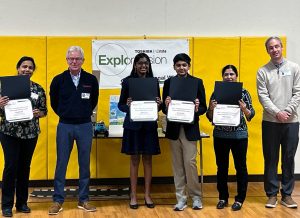Reflections of a First-Time ExploraVision Coach
By Sheetal Rajput, STEM School Highlands Ranch, Highlands Ranch, CO
As a first-time Toshiba/NSTA ExploraVision coach, stepping into the world of student-led innovation with a regional-winning team has been nothing short of inspiring. I had the privilege of guiding two brilliant 7th-grade students, Anirudh Rao and Aarna Varre, as they embarked on an ambitious journey to explore biomimetic surfaces for their ExploraVision project. The students had already been working on the initiative for a year and reached out to me with their desire to enter the competition and for me to serve as their coach.
ExploraVision is more than just a competition. It’s a launchpad for creative problem-solving, encouraging students to envision technology 20 years into the future. For me, as a coach new to the program, the most rewarding part was watching the students grow from curious thinkers to budding researchers and effective communicators.
Anirudh and Aarna chose to dive into the fascinating field of biomimicry, specifically focusing on how natural surfaces like mint leaves, the Namib beetle, and cicada wings could inspire the materials of tomorrow. Their idea was to design hydrophobic surface patterns that could be applied to roads to help melt ice faster or prevent the formation of black ice.
What amazed me most was their ability to connect across interdisciplinary subjects. They explored biology, physics, and pavement engineering, often asking insightful questions and even interviewing local Department of Transportation engineers. They reached out and had the opportunity to visit the concrete and asphalt lab at the Colorado Department of Transportation and observe real-world testing conducted on concrete and asphalt samples. This experience helped them understand the chemistry of these materials and plan their future proof of concept.

My role quickly evolved from “coach” to “co-explorer.” I learned alongside them, encouraging and motivating their progress every step of the way. The students spent time studying flora and fauna patterns, conducting freeze-thaw experiments with 3D-printed and asphalt samples, and mapping out the future of biomimetic applications. Together with their mentor, Bharathi Rao, we formed a powerful and collaborative team.

What I’ve learned through this journey is that great coaching doesn’t require having all the answers. It requires curiosity, patience, and the willingness to give students the support, resources, and space they need to thrive. ExploraVision gave us the structure to think big and dream beyond the boundaries of today’s technology. What I especially appreciated about the contest was that it valued ideas over results. It gave these students the opportunity to imagine a better, more sustainable world through science/technology and gave me the chance to witness the power of young minds when they are empowered to lead.

To future coaches: lean into the excitement and let your students explore. You might just end up learning more than you teach.
To learn more about the 2025-26 ExploraVision program, visit https://www.exploravision.org.